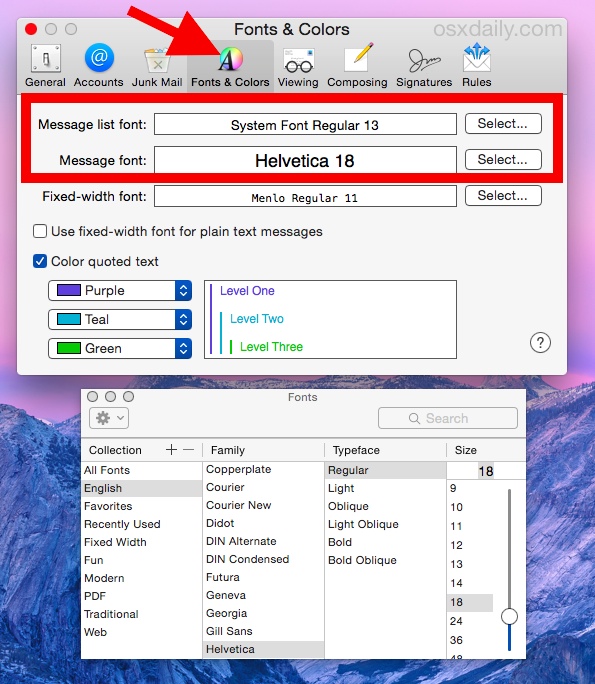- Change Font Size Mac Os X
- Os X Increase Font Size
- Font Size For Mac Os X 10.8
- Increase Text Size Mac Os
Change Fonts & Colors preferences in Mail on Mac. Use Fonts & Colors preferences in Mail to change fonts and font sizes for writing and viewing messages in Mail, and for distinguishing quoted text when replying to or forwarding messages. To change these preferences in the Mail app on your Mac, choose Mail Preferences, then click Fonts & Colors. Select Text Size, and you'll get a popup menu that lets you choose a font size of from 10 points to 16 points. Click Use as Defaults to apply this new font size to all windows in the current view.
Mail User Guide
Use Fonts & Colors preferences in Mail to change fonts and font sizes for writing and viewing messages in Mail, and for distinguishing quoted text when replying to or forwarding messages.

To change these preferences in the Mail app on your Mac, choose Mail > Preferences, then click Fonts & Colors.

Option | Description |
|---|---|
Message list font | The font and font size for viewing the list of messages. Click Select to use a different font. |
Message font | The font and font size for writing and viewing messages. Click Select to use a different font. If the sender used a specific font for a message, that font is used when viewing the message. |
Fixed-width font | The font and font size for writing and viewing plain text messages. Click Select to use a different font. You must select the option to use fixed-width font for plain text messages for the font to be applied. |
Use fixed-width font for plain text messages | Fixed-width fonts display every character with the same width. This font is useful when you’re trying to align text using spaces instead of tabs. |
Color quoted text | Show quoted text in colors. Click the color pop-up menu for a level to use a different color. Quoted text is the part of a message included when you’re replying or forwarding the message. It’s typically indented. |
If your recipients don’t have the same fonts that you used in your message, similar fonts are substituted.
Some of us like to control everything on our Mac. Now you can change the default system font of your Mac OS system by following these steps.
Change Font Size Mac Os X
1. Determine the font you want to change your Mac system font to. In this example, we will be using SF Archery Black font. For reference, you can view the following font files currently installed on your Mac in the locations provided below. Also, a great free front website is FontSquirrel. You will need a .TTF font file for this guide.
Mac OS X Font Folder Locations:
2. Copy the font your using to your Desktop. In the example, we copied SF Archery Black font to our Desktop.
3. We need to edit our Font file to be able to be used as a Mac OS X system font. Download TTFEdit. Once downloaded, open ttfedit.jar inside the ttfedit-1.0a-bin folder. You may be prompted to install legacy Java for Mac (or the latest version) in order to launch TTFedit. Go ahead and do this.
4. Open your font in TTFedit. File -> Open.
Os X Increase Font Size
5. Click on the name tab on the left side of the screen. Note the line PostScript name of the font. See below.
6. You will need to change this field to the default postscript name of Mac OS X Systems fonts. Note: this is not compatible with 10.11 El Captain.
Change the Postscript name of the font field to:
Font Size For Mac Os X 10.8
7. Save your edited font file with a different name (add something to it so as to not overwrite your current font file in this folder) to Hard Drive -> Library -> Fonts.
Increase Text Size Mac Os
8. Reboot your Mac. Your font should load and be visible now in your Mac system menus and areas.
